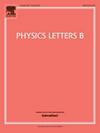轻子对撞机作为暗物质探测中通过冻结再加热的窗口。第一部分
IF 4.5
2区 物理与天体物理
Q1 ASTRONOMY & ASTROPHYSICS
引用次数: 0
摘要
我们提出了一种从暗物质中冻结的对撞机信号推断宇宙再热温度(TRH)的方法。我们在电子-正电子对撞机的单γ信号中证明了这一点,在解决观测到的DM丰度、BBN和其他相关限制后,这表明了低尺度TRH。该方法可用于关联不同的再加热动力学、DM模型和对撞机信号。本文章由计算机程序翻译,如有差异,请以英文原文为准。
Lepton collider as a window to reheating via freezing in dark matter detection. Part I
We propose a methodology to infer the reheat temperature () of the Universe from the collider signal of freezing in dark matter (DM). We demonstrate it for the mono- signal at the electron-positron colliders, which indicates to a low-scale , after addressing observed DM abundance, BBN, and other relevant constraints. The method can be used to correlate different reheating dynamics, DM models, and collider signals.
求助全文
通过发布文献求助,成功后即可免费获取论文全文。
去求助
来源期刊

Physics Letters B
物理-物理:综合
CiteScore
9.10
自引率
6.80%
发文量
647
审稿时长
3 months
期刊介绍:
Physics Letters B ensures the rapid publication of important new results in particle physics, nuclear physics and cosmology. Specialized editors are responsible for contributions in experimental nuclear physics, theoretical nuclear physics, experimental high-energy physics, theoretical high-energy physics, and astrophysics.
 求助内容:
求助内容: 应助结果提醒方式:
应助结果提醒方式:


